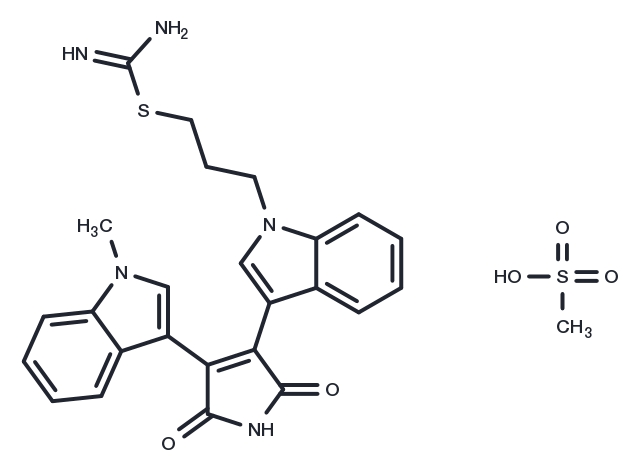Powder: -20°C for 3 years | In solvent: -80°C for 1 year


Ro 31-8220 Mesylate (Bisindolylmaleimide IX mesylate) is a pan-PKC inhibitor for PKC-α/βI/βII/γ/ε (IC50: 5/24/14/27/24 nM), and also shows potent inhibition against MSK1, MAPKAP-K1b, S6K1, and GSK3β.

| Pack Size | Availability | Price/USD | Quantity |
|---|---|---|---|
| 1 mg | In stock | $ 44.00 | |
| 2 mg | In stock | $ 62.00 | |
| 5 mg | In stock | $ 98.00 | |
| 10 mg | In stock | $ 162.00 | |
| 25 mg | In stock | $ 256.00 | |
| 50 mg | In stock | $ 355.00 | |
| 100 mg | In stock | $ 527.00 | |
| 1 mL * 10 mM (in DMSO) | In stock | $ 143.00 |




| Description | Ro 31-8220 Mesylate (Bisindolylmaleimide IX mesylate) is a pan-PKC inhibitor for PKC-α/βI/βII/γ/ε (IC50: 5/24/14/27/24 nM), and also shows potent inhibition against MSK1, MAPKAP-K1b, S6K1, and GSK3β. |
| Targets&IC50 | PKCα:5 nM, PKCβ2:14 nM, PKCγ:27 nM, PKCβ1:24 nM, PKCε:24 nM |
| In vitro | Within MLP/mice, Ro 31-8220 (6 mg/kg/d, s.c.) significantly enhances myocardial contractility. |
| In vivo | RO31-8220 effectively inhibits the growth of A549 cells (IC50: 0.78 μM) and MCF-7 cells (IC50: 0.897 μM). In platelets with low adrenergic response, RO31-8220 amplifies the phosphorylation of Akt, thereby enhancing adrenalin-induced platelet aggregation. It significantly reduces the secretion of apolipoprotein E from primary human macrophages by inhibiting the vesicular transport of the apoE gene to the plasma membrane, without significantly affecting the mRNA or protein levels of ApoE. RO31-8220 inhibits the activity of rat brain protein kinase C (IC50: 23 nM) without selectivity towards PKC-α/β/γ/ε isoforms. Additionally, RO31-8220 exerts an inhibitory effect on voltage-dependent sodium channels. |
| Kinase Assay | Assay of PKC Activity : Assay mixtures contain 0.2 mg/mL peptide-gamma, 10 μM MgCl2, 0.6 mM CaCl2, 10 μM [γ-32P]ATP, 1.25 mg/mL phosphatidylserine and 1.25 ng/mL phorbol 12-myristate 13-acetate in 20 mM Hepes (pH 7.5), 2 mM EDTA, 1 mM dithiothreitol and 0.02% (w/v) Triton X-100. Peptide-γ is a synthetic peptide, GPRPLFCRKGSLRQKW, resembling the PKC-γ pseudosubstrate site, except that a serine residue replaces the pseudosubstrate alanine, converting the peptide from an inhibitor into a substrat. The assays are started by the addition of 2.5 m-units of enzyme, incubated at 30 °C for 10 min and terminated by spotting on to P81 paper, followed by extensive washing in 75 mM orthophosphoric acid. The papers are then washed in ethanol, dried, and incorporated radioactivity is determined by liquidscintillation spectroscopy. |
| Cell Research | Human A549 lung and MCF-7 breast carcinoma cells are obtained from the European Collection of Animal Cell Cultures. Cells (passage number 10-30) are cultured in an atmosphere of 5% carbon dioxide, the former in Ham's F-12 medium with penicillin/streptomycin, the latter in minimum essential medium (Eagle's modification) with additional pyruvate (1 mM) and non-essential amino acids. Both media are supplemented with 10% FCS and glutamine (2 mM). Cells are subcultured routinely twice weekly to maintain logarithmic growth. For cell proliferation studies cells are seeded and incubated with 3 ml of medium including agents, which is replenished at intervals of 48 h (A549) or 72 h (MCF-7). Following incubation for 4 days (A549) or 6 days (MCF-7) with drugs, cell number is assessed using a Coulter Counter Model ZM. In order to achieve PKC depletion, cells are incubated for 24 h with bryostatin 1 (1 μM). Under these conditions growth inhibition caused by bryostatin 1 is negligible. Bryostatin is removed by extensive washing of the cells followed by a 2 h recovery period. In previous work using the A549 cell line this washing procedure has been shown to eliminate bryostatin-mediated effects. The cells are then incubated for a further 24 h with staurosporine, RO 31-8220, UCN-01 or H-7. In some experiments cells are incubated with inhibitor for 48 rather than 24 h, in this case bryostation was not removed and left in the incubate. After removal of agents inhibition of DNA synthesis is evaluated by measurement of [3H]Tdr incorporation into cell. Radioactivity is counted using a Packard 1500 Tricarb scintillation counter. (Only for Reference) |
| Synonyms | Ro 31-8220 methanesulfonate, Bisindolylmaleimide IX, Bisindolylmaleimide IX mesylate |
| Molecular Weight | 553.65 |
| Formula | C25H23N5O2S·CH4O3S |
| CAS No. | 138489-18-6 |
Powder: -20°C for 3 years | In solvent: -80°C for 1 year
Ethanol: 2.8 mg/mL (5 mM)
DMSO: 55.4 mg/mL (100 mM)
You can also refer to dose conversion for different animals. More
bottom
Please see Inhibitor Handling Instructions for more frequently ask questions. Topics include: how to prepare stock solutions, how to store products, and cautions on cell-based assays & animal experiments, etc.
Ro 31-8220 Mesylate 138489-18-6 Chromatin/Epigenetic Cytoskeletal Signaling PKC inhibit Ro 31-8220 methanesulfonate Inhibitor Bisindolylmaleimide IX Ro 318220 Mesylate Protein kinase C Ro 31 8220 Mesylate Bisindolylmaleimide IX mesylate Bisindolylmaleimide IX Mesylate Ro 31-8220 inhibitor
